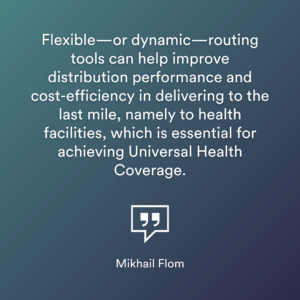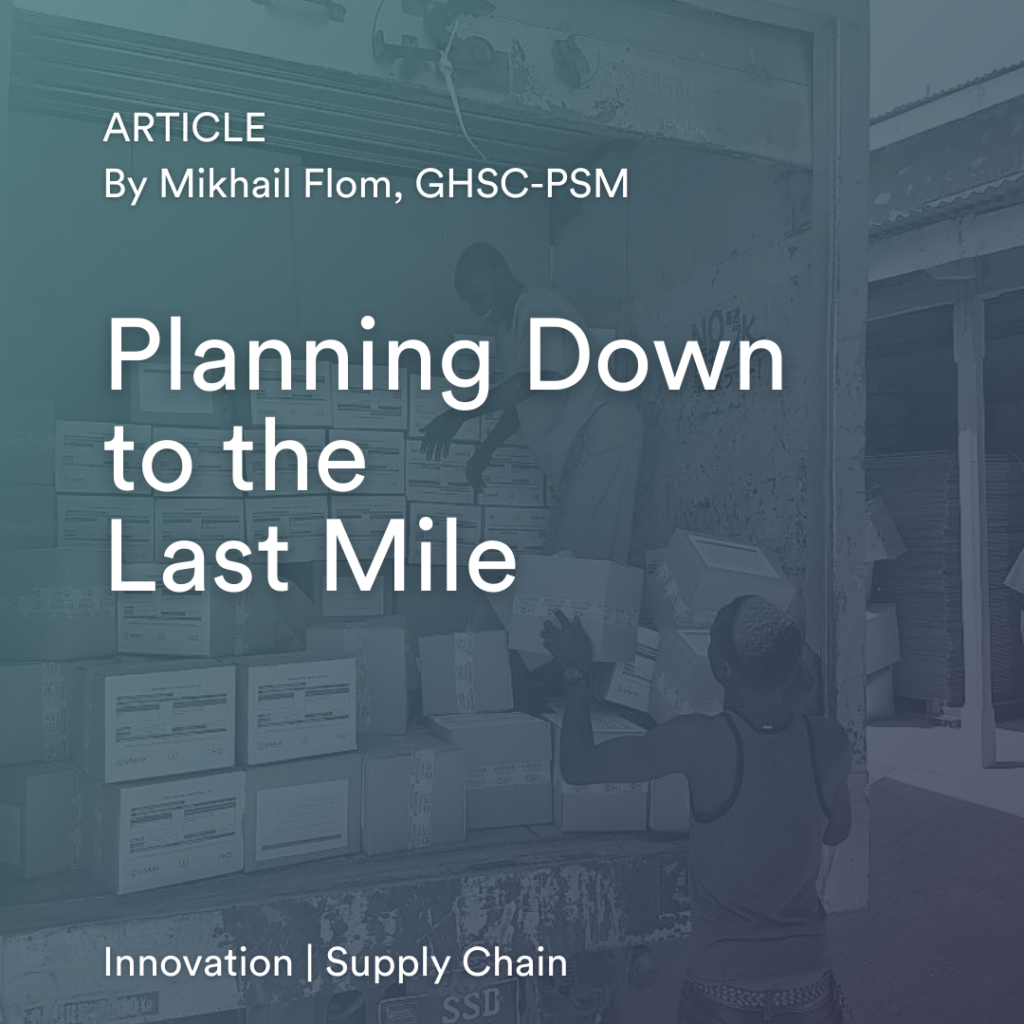By Mikhail Flom, data analyst with GHSC-PSM.
DOWNLOAD: Technical Report: Last Mile Dynamic Routing
Last-mile distribution is a critical step in the supply chain for ensuring people have access to medicines and contraceptives when and where they need them. But logistics challenges can slow deliveries considerably. These challenges include limited infrastructure; unstable technology; poor data for decision-making; and a shortage of funding, transportation assets and human resources. The COVID-19 pandemic has further strained supply chains, making tools for running them more efficiently even more important.
 Flexible—or dynamic—routing tools can help improve distribution performance and cost-efficiency in delivering to the last mile, namely to health facilities, which is essential for achieving Universal Health Coverage. Dynamic routing is the opposite of static—or unchangeable—routing, which is done when there is a lack of timely information and limited ability to use the information for planning. Dynamic routing automates the routing planning process, enabling it to account for multiple factors, such as an operation’s existing resources and availability, and then determines the most effective routing that works within known constraints. It can also incorporate external factors such as weather, traffic, blockage and security patterns to adjust routes and keep drivers on the most efficient path possible.
Flexible—or dynamic—routing tools can help improve distribution performance and cost-efficiency in delivering to the last mile, namely to health facilities, which is essential for achieving Universal Health Coverage. Dynamic routing is the opposite of static—or unchangeable—routing, which is done when there is a lack of timely information and limited ability to use the information for planning. Dynamic routing automates the routing planning process, enabling it to account for multiple factors, such as an operation’s existing resources and availability, and then determines the most effective routing that works within known constraints. It can also incorporate external factors such as weather, traffic, blockage and security patterns to adjust routes and keep drivers on the most efficient path possible.
The USAID Global Health Supply Chain Program-Procurement and Supply Management (GHSC-PSM) project has conducted market research to identify and categorize existing dynamic routing offerings, which fall into three categories (see box) to help supply chain managers make deliveries more timely and reliable. The GHSC-PSM team reviewed past performance and experiences in the last mile market, conducted interviews with select providers and synthesized the findings to develop a comprehensive list of offerings and insights on current trends.
|
Dynamic Routing Options Commercial: Supply chain planners pay a company to come up with dynamic routing options. Open source: A community has built or sourced solutions that supply chain planners can use. It is already a complete tool so minimal tailoring is required. Build your own: Mathematical tools have been created for the customer to devise a tailored solution, which requires a good deal of customer technical know-how. |
The USAID Global Health Supply Chain Program-Procurement and Supply Management (GHSC-PSM) project has conducted market research to identify and categorize existing dynamic routing offerings, which fall into three categories (see box) to help supply chain managers make deliveries more timely and reliable. The GHSC-PSM team reviewed past performance and experiences in the last mile market, conducted interviews with select providers and synthesized the findings to develop a comprehensive list of offerings and insights on current trends.
In today’s market there is growing demand for speed, cost and convenience, rendering flexibility, real-time visibility, customized automation and usability among the most important characteristics of routing software. Having flexibility in delivering at the last mile has been especially important during the COVID-19 pandemic. For example, what happens if drivers or warehouse staff become ill? Which drivers, vehicles and staff can fill the gaps? Flexibility is also needed for routing and delivery times as communities lock down or impose curfews to prevent the spread of the virus.
In one way, a supply chain is among the most basic components of delivering health care. A vehicle takes commodities from one point to another. But in resource-poor settings even a straightforward task can become complicated if the volume of commodities won’t fit on one truck, if a truck breaks down, if a driver falls ill or seasonal rains cut off access to facilities.
Planning is the key to an effective supply chain. While Logistics Management Information Systems might provide information on commodities, they do not provide the flexibility of giving visibility to changing volume if the central warehouse delivers twice the anticipated volume. As a result, commodities delivered to a dispatch area could end up sitting there for weeks because the static system did not allow for more volume. Staff can be left scribbling long division problems on boxes to see how many cartons of contraceptives can fit onto a 10-cubic meter truck bed.
GHSC-PSM wanted to fill this gap, given the proliferation of digital tools at its disposal, to make planning more effective. At the vanguard of using these tools are countries such as Zambia, Cameroon and Haiti, which are increasingly using digital tools to help run more efficient supply chains.
The future of supply chains is going digital. This research serves as a starting point for organizations interested in the capabilities of existing dynamic routing offerings that can utilize data more effectively to get medicines and contraceptives to health facilities and villages—and get them there more efficiently and successfully.
Mikhail Flom is a data analyst with GHSC-PSM.
For more information, please contact GHSC-PSM Advanced Analytics Manager Andrew Inglis (ainglis@ghsc-psm.org) and Operational Excellence and Optimization Team Manager Dr. Hua Ni (hni@ghsc-psm.org)






